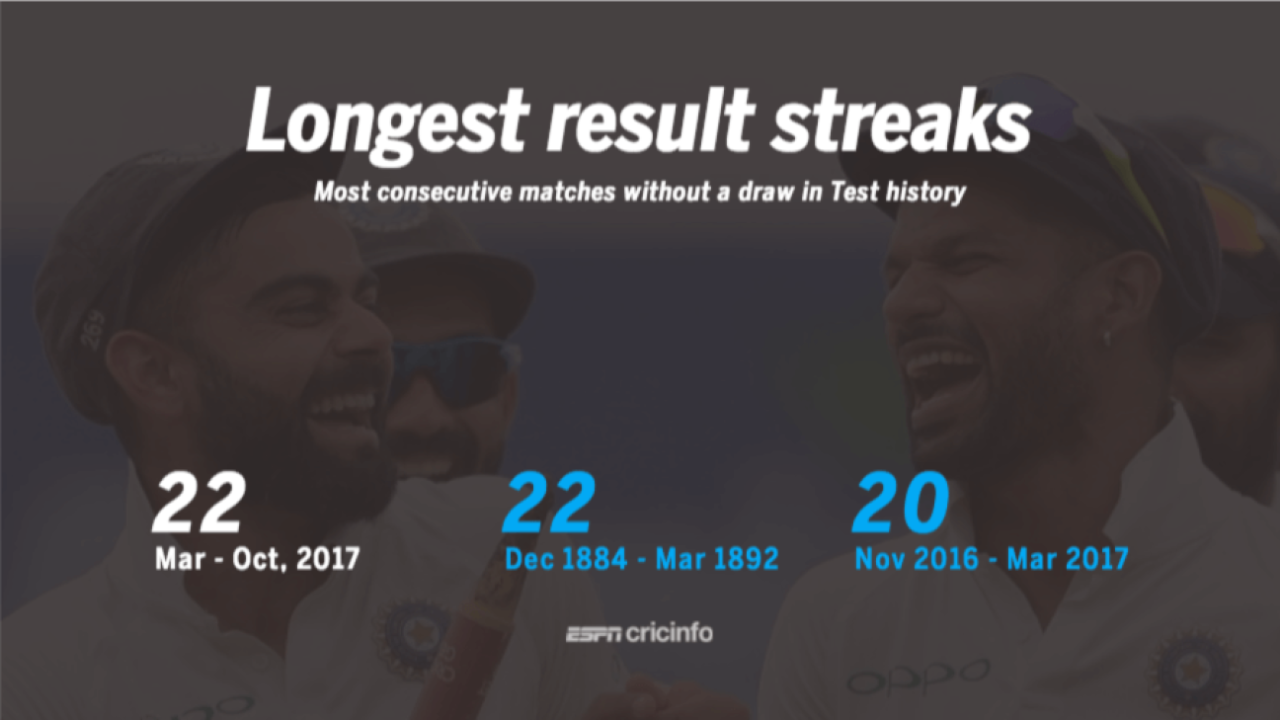A sequence of 22 successive Tests with decisive results ended
in Bulawayo when Zimbabwe held on to draw the second against West Indies. That result halted a run that began on March 25, when India beat Australia by eight wickets
in Dharamsala, and continued till the first Test of the Zimbabwe-West Indies series, which the visitors
won by 117 runs.
Had West Indies sealed the win in Bulawayo, it would have broken the record for the longest such streak in Test cricket - between
December 1884 and March 1892 too, there were 22 successive Tests without a draw. (There was
one game during this period which was abandoned without a ball being bowled.) The next-highest draw-less streak has also happened within the last year, between
November 12, 2016 and March 7, 2017, when 20 consecutive Tests produced decisive results. That two of the longest such streaks have happened within the last year shows very strongly the direction that Test cricket is moving towards.
Thanks to the 22-match streak in 2017, 89% of Tests this year have had a winner (
33 out of 37). This is the highest ever among the 75 calendar years in which at least 10 Tests have been played.
Before the Bulawayo draw, two of the three drawn Tests in 2017 had been affected by the weather: the last days in
Dunedin and in
Hamilton were completely washed out on South Africa's tour to New Zealand, with the home team denied victory after being in an especially dominant position in Hamilton. The only other draw was
in Ranchi, when the batsmen from both India and Australia made merry.
The overall result percentage of 89.2 this year is one of only six years when the win percentage has been at least 80%; four of those six years have happened since 2000, and three have come about in the last four years, which again is a clear reflection of how result-oriented Test matches have become. In fact, the only year to miss the 80%-mark in the last four years did so very narrowly: in 2015, 34 out of 43 Tests ended decisively, a percentage of 79.07. Each of these last four years are among the top seven calendar years to have the
highest percentage of decisive results.
Over these last seven years, 140 out of 168 Tests have ended decisively, which is a healthy 83%. Breaking these numbers down by host country, eight of the ten countries have a result percentage of at least 80. Sri Lanka lead the way with 20 results in 21 games, followed by England and the UAE, but surprisingly, Australia are near the bottom of this table, with four draws in 17 games. The only host country with a poorer result record during this period is Bangladesh (five draws in 14 Tests). The high batting average in these 17 Tests in Australia is also indicative of the generally friendlier batting conditions here in the 2014-15 and 2015-16 seasons.
The other number to pay attention to in the table above is the overs-per-win column, which is the average number of overs bowled in the Tests which ended decisively in each of these host countries. In the 20 Tests that ended decisively in Sri Lanka, for example, the average length of a match was 334 overs, which, assuming 90 overs a day, is about a session short of four days. In England and in South Africa, that average is fewer than 310 overs, but in the UAE it goes up to 391, which is four days plus a session. Overall since the start of 2014, the average is 331 overs for a decisive Test match.
Over the last few decades, the result percentage in Tests has clearly gone up, while overs per result has remained in the 315-330 region. It is a combination of these numbers - the last two columns in the table below - that has encouraged the idea of the four-day Test.
The topic has become even more relevant after the ICC allowed South Africa to experiment with one when Zimbabwe tour there later this year. Of course, none of these numbers will be relevant in day-night Tests, where the conditions and the balls used are so different that the stats from day games won't matter, but if the day games move from five to four as well, then these numbers become important.
Of the 140 Tests than have ended decisively since the start of 2014, 59 have gone beyond 350 overs, which is roughly four days of 90-over cricket, with some allowance for change of innings. (In 2017, it is 12 out of 33.) This obviously includes instances when teams have batted longer than necessary in the third innings, knowing that they had a fifth day to bowl the opposition out, but it does offer an idea of the length of Test matches over the last few years. (The idea of four-day Tests includes more overs per day, but that may not be possible in every country.)
For the moment, though, despite the blip in Bulawayo, Test cricket remains on a result-oriented course. With ten Tests to go in 2017 - four Ashes matches in Australia, three in the India-Sri Lanka series, two between New Zealand and West Indies, and the day-night Test between South Africa and Zimbabwe - this could well be the
first time a year with ten-plus Tests has had decisive results in more than 90% of the matches.
Nov 3, 1245 GMT: The piece was edited to reflect the fact that the 22-match streak without a draw equals the longest such sequence in Test history.


